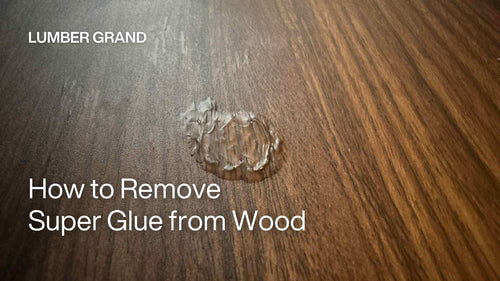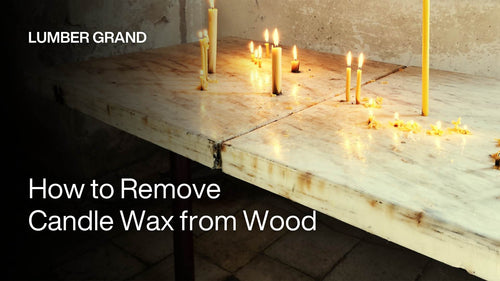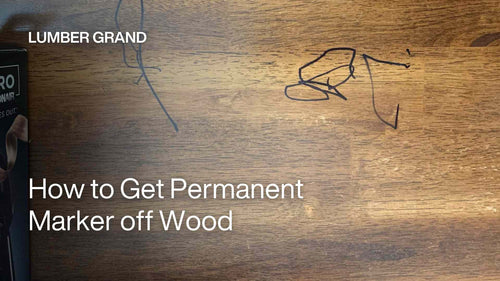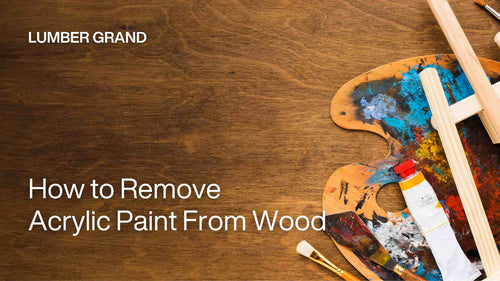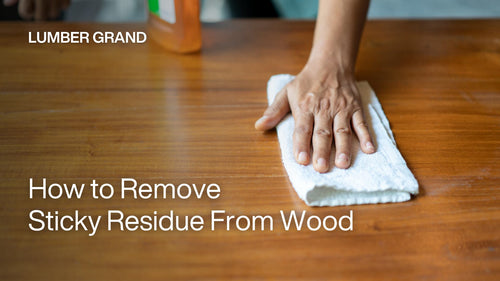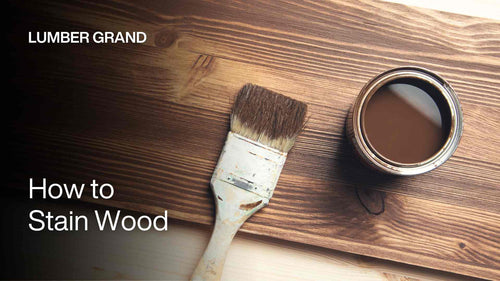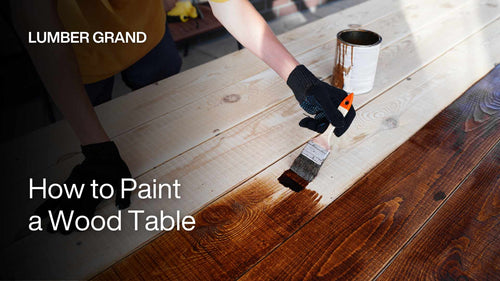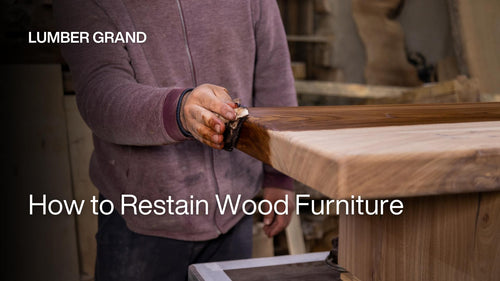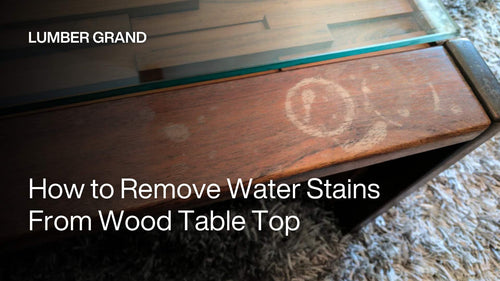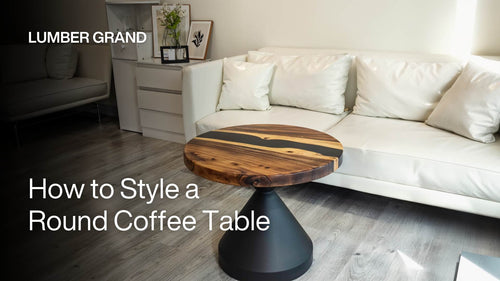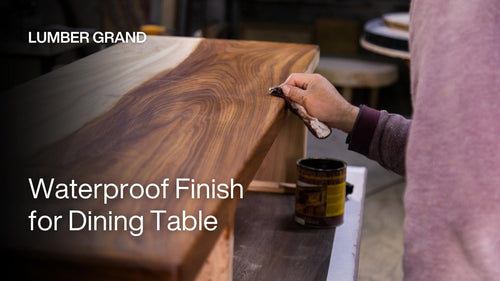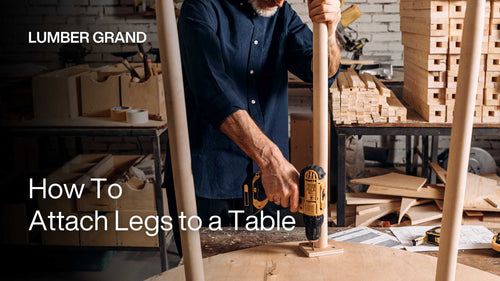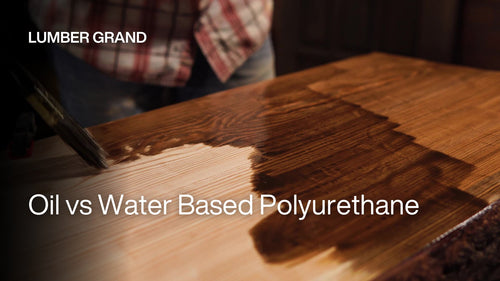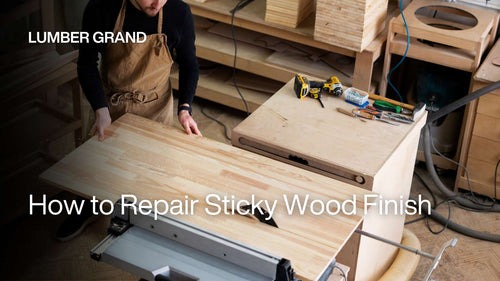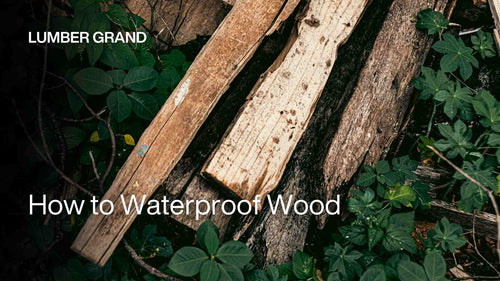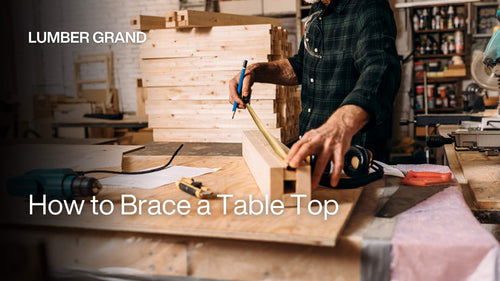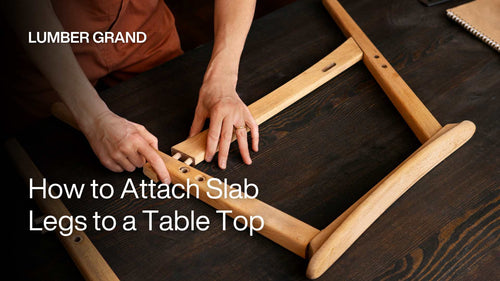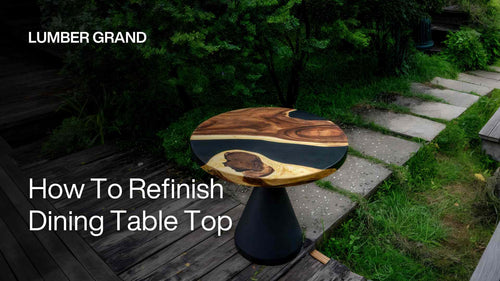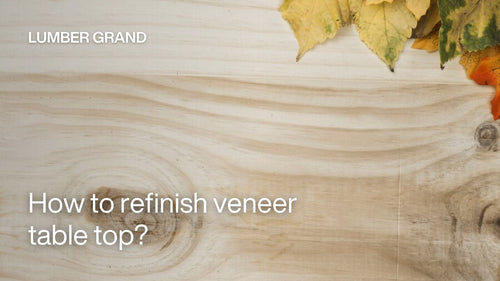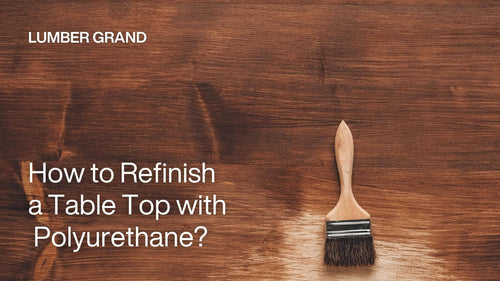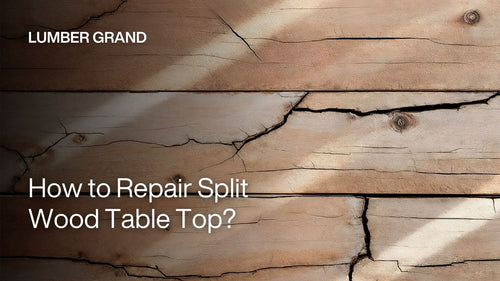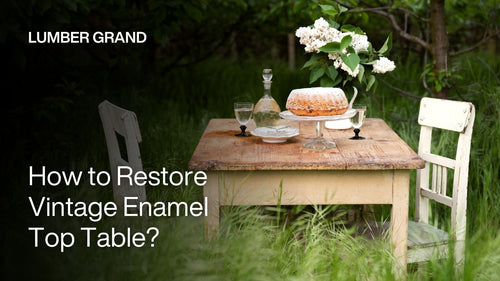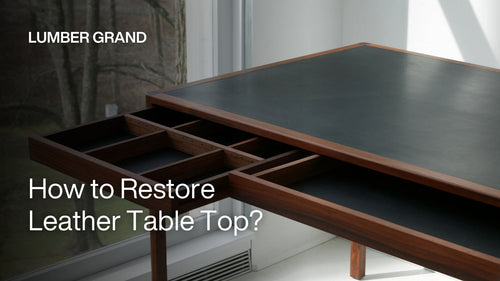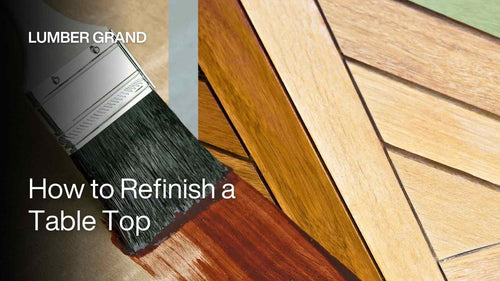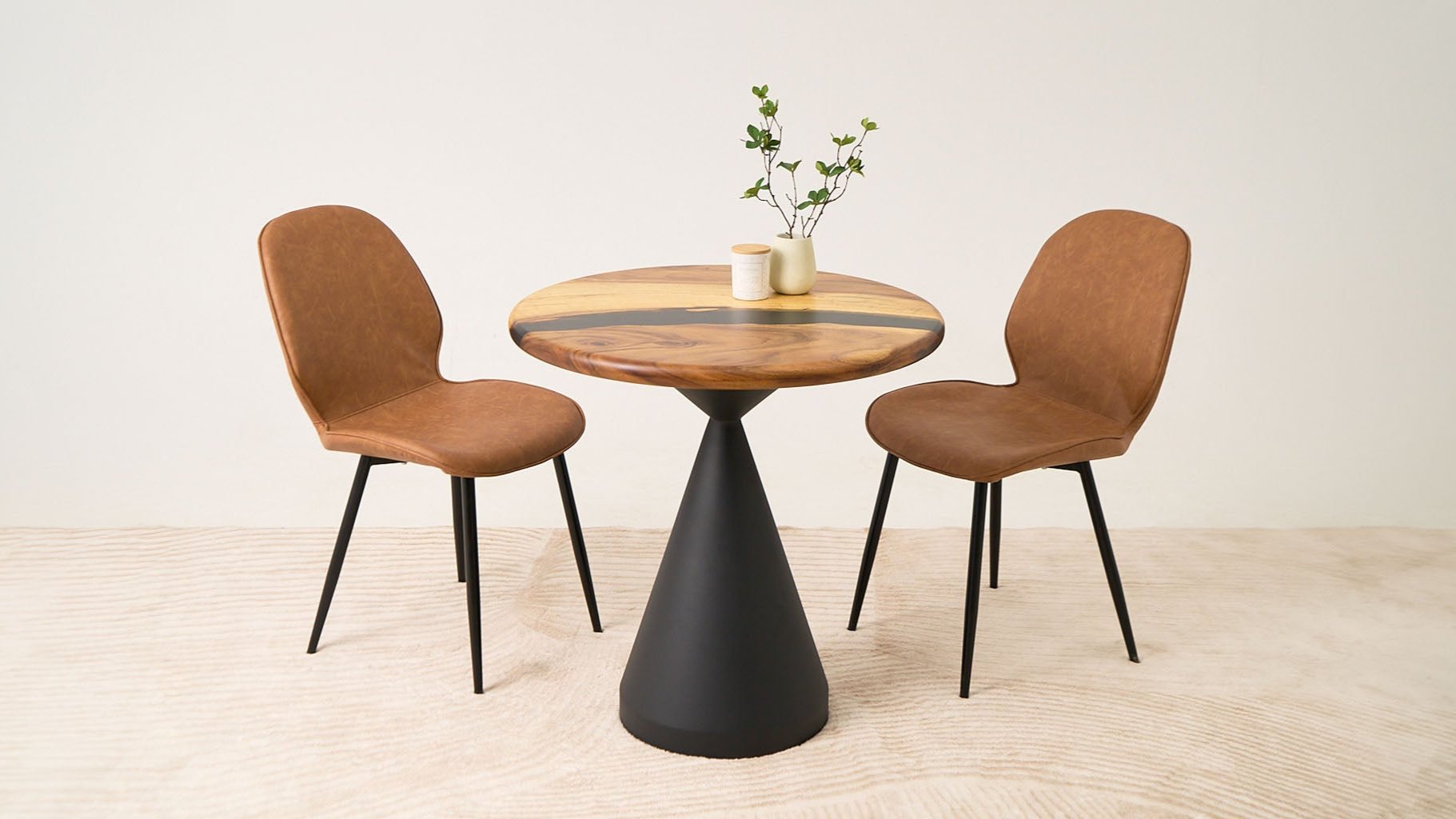How to remove oil stains from wood is one of those cleaning challenges that can make your heart sink. That dark, greasy mark looks like a disaster. Luckily, you can remove most oil stains with simple items you already have at home.
Fresh spills might only need soap and water. Older stains that have set in respond well to baking soda, cornstarch, or mineral spirits. In this guide, Lumber Grand walks you through 5 fast ways on how to get oil out of wood. Each method uses everyday items, and we'll show you exactly when to use each one. Read now!
Why Oil Stains are So Stubborn on Wood
Wood is naturally porous, which means it has tiny channels and gaps in its grain that work like sponges. When oil touches wood, it quickly soaks into these pores and often penetrates deep below the surface within minutes.

A scalable high-porosity wood for sound absorption and thermal insulation
Photo: Nature [1] | Remake: Lumber Grand
Yet, those epoxy tables create a waterproof coating, so oil stays on the surface instead of soaking in. That's why epoxy tables are effortless to clean — a quick wipe with a damp cloth handles most oil spills without leaving a trace.

Epoxy is highly resistant to oil, making it a durable finish for tables that may encounter spills
Shop now: Square Wood Epoxy Dining Table Top 35" x 35"
Credit: Lumber Grand
But for traditional + basic wood tables, especially bare or lightly finished ones, oil penetration happens fast.
This is why you need to learn how to get oil stain out of wood table asap. Fresh spills you clean up right away can often be removed with just soap and water. Old stains that have had time to soak in and oxidize usually need stronger solvents like mineral spirits.
Also, the difference between fresh and old stains matters:
-
Fresh stains, less than 24 hours old, haven't fully penetrated yet, so surface treatment usually works.
-
Old stains from days, weeks, or months ago have oxidized and bonded with the wood fibers, so they need deeper treatment.
How to Remove Oil Stains from Wood: 5 Easy Ways with Household Items
Because wood is porous, which means oil goes in, but it can also come back out. You just need the right ways below, based on how old the stain is and what surface you're dealing with.
1. Fresh Oil Spills: The Soap & Water Solution
Best for: How to get oil out of wood immediately after a spill | Fresh cooking oil, olive oil, vegetable oil spills
When you've just spilled oil on wood, time matters most. Professional cleaning specialist Jimmy emphasizes this: Your best bet is to wash it immediately before the stain soaks too deeply into the wood.

How to get a grease stain out of wood
Photo: Freepik
What you'll need:
-
Paper towels or newspaper
-
Warm water
-
Mild dish detergent (Dawn works great)
-
Soft cloth or cotton ball
-
A clean towel for drying
-
Rubber gloves (optional, for sensitive skin)
How to remove oil stains from wood with simple household items:
-
Step 1: Press paper towels firmly onto the spill to soak up as much oil as you can (Don't rub). Replace the paper towels as they get saturated. Keep blotting until no more oil comes off on the paper.
-
Step 2: Mix warm water with mild dish detergent in a bowl. Use a 2:1 ratio, which is 2 parts water to 1 part soap. Then, you mix it with your hands to get good suds going.
-
Step 3: Dip a soft cloth or cotton ball into the suds, not the liquid underneath, and apply it to the stained area. Rub gently in circles, working with the wood grain when you can.
-
Step 4: With deeper stains, you use a soft-bristled brush to work the suds into the grain, but be gentle.
-
Step 5: Wipe the area with a clean, damp cloth to get rid of the soap residue.
-
Step 6: Pat the area dry with a clean towel, then let it air dry all the way. Once it's dry, check if the stain is still there. If you still see discoloration, you should move on to Method 2 or 3.
You might like: How to Remove Heat Stains from Wood
2. Baking Soda Treatment: The Kitchen Staple Hero
Best for: Baking soda to remove oil stain from wood | Outdoor furniture, bare wood, stubborn fresh stains
Baking soda works really well for oil stains because it absorbs oil so effectively. One of our readers shared how they removed oil from a bare wood side table: "I just used bicarbonate soda to remove oil from a bare wood side table top. It only took a few minutes to remove. I poured a fair amount on the stain and then just rubbed it over the stain by hand."
Indeed, it works especially well on unfinished wood or outdoor furniture, where you can be more aggressive without worrying about damaging a finish. We’ll have 2 ways to clean up those oil stains with baking soda.

How to remove oil stain from wood with pure baking soda
Photo: Shutterstock
What you'll need:
-
Baking soda
-
Water
-
Mixing bowl
-
Paper towels
-
Soft brush or cloth
-
Damp cloth for cleanup
Here is how to remove oil stains from wood with baking soda in 2 ways:
2.1 Paste Method (for Stubborn Oil Stains)
-
Step 1: Remove any surface oil with paper towels first
-
Step 2: Mix baking soda with water until it's thick, like toothpaste.
-
Step 3: Test it on a hidden spot first to make sure it won't be too rough on your wood finish.
-
Step 4: Spread the paste over the entire stain and cover it completely.
-
Step 5: We’ll need to wait for 30 minutes. In case of tougher stains, you can leave it up to an hour.
-
Step 6: Use a soft brush or cloth to work the paste into the stain in a circle
-
Step 7: Wipe away the paste with a damp cloth and pat dry
2.2 Direct Application (Quick Fix)
For lighter stains on bare wood, we can skip the paste and pour baking soda straight onto the fresh oil stains. Next, you rub it in by hand in circles for a few minutes, then wipe it clean.
Besides, you can also add a small squirt of dish soap to your baking soda paste for extra grease-cutting power. The baking soda soaks up the oil. At the same time, the soap cuts through the grease, so together they can handle some pretty tough stains.
3. Cornstarch Overnight Treatment
Best for: Deep-penetrating stains on indoor wood furniture | When you need a gentle, non-abrasive option
Cornstarch works like baking soda but is even gentler, so it's perfect for finished furniture. It soaks up oil really well and pulls it toward the surface. This method works quite slowly, but it draws the oil out of the wood over several hours.

How to remove oil stains from wood floors, table with cornstarch
Photo: Gettyimages
What you'll need:
-
Cornstarch (generous amount)
-
Vacuum cleaner
-
Soft cloth
-
Your patience!
How to get oil stains out of wood overnight:
-
Step 1: Pour cornstarch all over the stained area. The more cornstarch you use, the more oil it can soak up.
-
Step 2: You leave the cornstarch there for 8 to 12 hours. Overnight works great. During this time, the cornstarch pulls oil out of the wood.
-
Step 3: Vacuum up all the cornstarch and look at the stain. Has it gotten lighter? If so, you're making progress.
-
Step 4: With stubborn stains, we do this 2 or 3 nights in a row. Each time pulls out more oil.
-
Step 5: Once the stain is gone or even better, wipe the area with a barely damp cloth and pat it dry. You can apply wood polish if you want.
4. Mineral Spirits for Old, Set-In Stains
Best for: How to remove old oil stains from wood table | Stubborn, oxidized stains that soap couldn't remove
When you're dealing with an oil stain that's been there for days, weeks, or even months, Mineral spirits will do the job. This is the go-to method for how to get oil stain out of wood tables when gentler methods haven't worked.
Mineral spirits are petroleum-based solvents designed for cleaning, thinning paint, and removing stubborn residues. They're strong enough to break down old oil that's soaked into the wood, but they won't hurt your wood finish if you use them the right way.

How to remove old oil stains from wood table with mineral spirits
Photo: Alamy
What you'll need:
-
Mineral spirits (available at hardware stores)
-
Clean white cloths or cotton balls
-
Rubber gloves
-
Mild dish detergent
-
Warm water
-
Wood polish
-
Soft polishing cloth
How to remove old oil stains from wood table in 7 steps:
-
Step 1: Dampen one corner of a clean white cloth or cotton ball with mineral spirits. Make sure to make it damp, not dripping.
-
Step 2: Work on small sections at a time, about 6 inches square. Rub firmly in circles over the stained area.
-
Step 3: Here, you should start to see the oil stain lifting onto your cloth. When the fabric gets dirty, you switch to a clean section or grab a fresh one.
-
Step 4: With stubborn stains, you should repeat this 2 or 3 times.
-
Step 5: Once the stain is removed or significantly lightened, you wipe the area with a cloth dampened with warm, soapy water to remove any mineral spirits residue. Then wipe with clean water and pat it dry.
-
Step 6: Let the wood air dry for several hours. This is when you'll really see if the stain is gone.
-
Step 7: Once it's completely dry, we apply wood polish with a soft cloth in circles. After you've coated all areas evenly, let it dry again for a few hours to a day.
Note: The stain might look worse right after you treat it, but it'll lighten up as it dries. If the stain is really old, you might not get it completely 100% out, but you can usually make it a lot.
5. Remove Oil Stains from Wood Surface-Specific Solutions
The fact is that different wood surfaces need slightly different approaches. Here's how to remove oil stain from wood furniture, floors, and other specific surfaces.
5.1 How to Remove Oil Stains from Wood Floors
Oil on wood floors is both an eyesore and a safety issue since it makes the floor slippery. Floor stains also tend to be bigger and need more cleaning supplies.
-
Step 1: Cover the entire spill with paper towels or newspaper. Or, you can use old towels you're okay with tossing out for big spills.
-
Step 2: Next, you use the soap solution method 1 we covered earlier, but work in small sections so water doesn't spread everywhere.
-
Step 3: Dry it really well. It’s better to use fans to speed up drying and keep water from damaging the wood.
-
Step 4: For old floor stains, mineral spirits work well, but you should test them in a hidden spot first since floor finishes vary.
Note: If your floor has polyurethane finish or another protective coating, the oil probably hasn't soaked in too deeply. In such cases, we advise you to start with soap and water before trying anything stronger.
Secondly, if you catch it within the first hour, it's much easier to remove on any hardwood floor. For large fresh spills, pour cat litter or floor dry products all over the oil. Let it sit for 30 minutes, then sweep it up. After that, you can easily clean with soap and water.
5.2 How to Get Oil Stain Out of Wood Table
Wood tables are tricky because everyone sees them, and they're often the main piece in a room. Whether it's an olive oil bottle that leaked or something from last night's dinner, you need to be extra careful with table stains.
-
For fresh spills on tables: You should use Method 1 (how to get oil out of wood floor with soap and water) right away. Most fresh spills clean up well if you catch them quickly.
-
For old stains on tables: If you wonder how to remove oil from a wooden table after an olive oil bottle leaked and sat too long. The answer is mineral spirit. But be ready to do it several times.
-
For bare wood tables (heavy-duty method): If your table is unfinished, try mixing baking soda or sawdust with mineral spirits or rubbing alcohol until it's like toothpaste.
Warm up the wood with a hair dryer first to help the oil flow more easily. Apply the paste with a soft brush and leave it for an hour. Then rinse it off or wipe it clean. Repeat if you need to.
5.3 How to Remove Oil Stain from Wood Veneer (Extra Gentle Approach)
Veneer is a thin layer of real wood, often just 1/32 inch thick, glued onto cheaper material underneath. If you scrub too hard, use rough materials, or get it too wet, you can damage the veneer or make it peel off permanently.

How to remove oil stains from wood veneer
Photo: Freepik
And, since wood veneer is too thin, we have safe methods for how to remove oil stain from wood veneer:
-
First Try: Mild soap solution (Method 1) and barely any pressure
-
Second Try: Very light application of mineral spirits on a cloth that's just slightly damp
-
Third Try: Try the cornstarch method, where you leave it on overnight to soak up the oil (see Method 3 above).
You might like: How to Refinish a Veneer Table Top
Popular Mistakes that Make Oil Stains on Wood Worse
Learning what to avoid is just as important as knowing what to do. Here are the biggest mistakes people make when trying to get oil stains out of wood:
-
Rubbing instead of blotting: When you rub a fresh spill, you push the oil deeper into the wood grain and spread it over a bigger area. This is the worst thing you can do. Hence, always blot first.
-
Using rough tools on finished wood: Steel brushes, rough sandpaper, or scouring pads will scratch and ruin wood finishes. As a woodworker expert, Jimmy suggests using a cotton ball or soft rag to clean wood surfaces.
-
Letting water soak into the wood: Water damages wood. Therefore, if it sits too long, it causes warping, swelling, and ruins the finish. Always wipe up water quickly and never let wood sit in standing water.
-
Using the wrong method for veneer: Treating veneer like solid wood is asking for trouble. The thin layer can't handle hard scrubbing, rough materials, or too much moisture. As a result, it’s best to begin with the gentlest method on veneer.
-
Giving up after one try: A member of our team tried 5 times before getting good results on an old table stain. Please don't give up. Most stubborn stains need 2 to 4 rounds of treatment.
-
Skipping the test spot: Every wood finish reacts differently to cleaning products. So, don’t forget to test your method on a hidden spot first. For example, under the table, inside a cabinet door, or on the back of the piece.
-
Using too much product: More isn't better for how to get oil off wood floor. Whether it's mineral spirits or a cleaning solution, using too much can soak the wood and cause more problems. You can start with less, then add more later if needed.

Biggest mistakes people make when trying to get oil stains out of wood
Photo: Freepik
Troubleshooting Guide: When Oil Removal Methods Don't Go As Planned
1. "I tried soap and water, but the stain is still there."
The stain has probably soaked in deeper than the surface. You should switch to mineral spirits for deeper cleaning. The stain is likely older than you think, or the wood is more porous than usual.
2. "The stain looks lighter but won't go away completely."
You're making progress. This usually means you need to do it a few more times. Try your method 2 or 4 more times, making sure the wood dries completely between each try. Facing really old stains, we think getting 80 to 90% improvement might be as good as it gets.
3. "The wood looks damaged or dull after I cleaned it."
You've probably taken off some of the finish along with the oil. You can fix it like this:
-
Step 1: Lightly sand with 220-grit sandpaper.
-
Step 2: Apply wood polish or finishing oil.
-
Step 3: Let it dry for 24 hours.
-
Step 4: Apply a second coat if needed.
Read the detailed process at: How To Refinish A Table Top Without Stripping
4. "I'm not sure if my furniture is solid wood or veneer."
You’ll need to look at the edges. Veneer shows layers — a thin outer layer over a different material underneath. Solid wood shows the same grain all the way through. If you're not sure, treat it like a veneer and use only gentle methods.
5. "The stain looks worse after using mineral spirits."
Okay, don't panic. Mineral spirits can darken wood temporarily as they soak in. Wait for it to dry completely, at least 8 hours, but overnight is better. You'll only see the real result once the wood is completely dry. If it's still dark, you might have pushed the oil deeper. Last resort, let’s try the cornstarch method overnight to pull it back out.
6. "Nothing is working — I've tried everything."
At this point, you have three choices:
-
Accept it: Sometimes a slight discoloration is fine, especially if it blends with the wood grain.
-
Get professional help: With some valuable or antique pieces, you should talk to a professional furniture restorer. They have industrial-strength products and techniques you can't buy.
-
Refinish the whole thing: If the piece is worth it, sand down the entire surface and refinish the table. This guarantees results but takes time, skill, and effort.
FAQs
1. How do I Know If the Oil Has Penetrated too Deep to Remove?
Here are some signs the oil has gone very deep into the wood:
-
Look at the stain. Does it have a dark center with lighter rings around it, like a halo? Can you see the stain coming through on the back side? Does the wood look dark and muddy even after it dries? These all mean the oil went deep.
-
Try cleaning it a few times with mineral spirits. If it doesn't get any better after 3 or 4 tries, the oil is deep in there. You might also smell something rancid from the old oil. Or the wood may feel soft or spongy where the stain is.
-
How long has the stain been there? Fresh stains under 24 hours usually stay near the top. But stains that have been sitting for months or years have probably soaked way down into the wood.
2. Can You Remove a Dried Oil Stain?
Yes, you can definitely remove dried oil stains from wood. In fact, most oil stain removal methods are made for dried, set-in stains rather than fresh spills.
3. Can I Use These Methods on Antique Furniture?
Yes, but you should be very careful with antiques. The finish on antique furniture is often shellac, lacquer, or old varnish that modern solvents can damage.
With valuable antiques, you should remove oil with the gentlest method, like soap and water. If that doesn't work, talk to a professional furniture restorer before trying anything stronger. The cost of professional restoration is almost always less than the value you'll lose if you damage an antique.
Related blog: 4 Easy Steps on How to Restore Vintage Enamel Top Table
4. Will Vinegar Remove Oil from Wood?
No, vinegar doesn't work for removing oil from wood. The reason is that oil and vinegar don't mix. Vinegar is water-based, while oil repels water. Since they don't dissolve each other, vinegar can't break down or lift oil stains from wood.
5. How Long Does It Take to Remove Oil from Wood?
Well, it depends on how old the stain is and how bad it is:
-
Fresh spills take about 15 to 30 minutes with soap and water.
-
Recent stains, 1 to 3 days old, need a few hours with baking soda or mineral spirits.
-
Old stains from weeks or months ago need multiple treatments over 2 to 3 days.
-
Really old, set-in stains might need 4 to 5 treatment cycles over a week.
How to Remove Oil Stains from Wood: Guide Ends Here
An oil stain on hardwood floor and wood tables is both an eyesore and a safety issue since it makes the floor slippery. Whether you're dealing with how to remove oil stains from wood floors, trying to get oil out of a wood table, or cleaning hand oil buildup on furniture, you now have several proven methods to choose from.
Most importantly, know when good enough is actually great. Sometimes, getting 90 to 95% improvement is realistic and satisfying, especially for really old stains. A slight discoloration that blends with the natural wood grain is often invisible to everyone but you.
Plus, if you have questions about how to remove oil stains from wood, our team at Lumber Grand is here to help. Check out our other helpful blogs every week, too. Thank you for reading!








